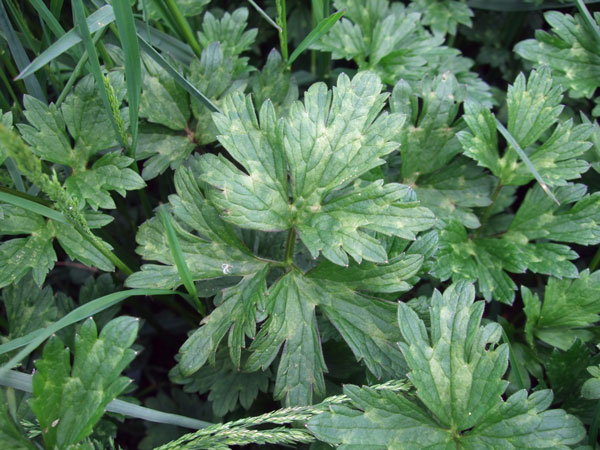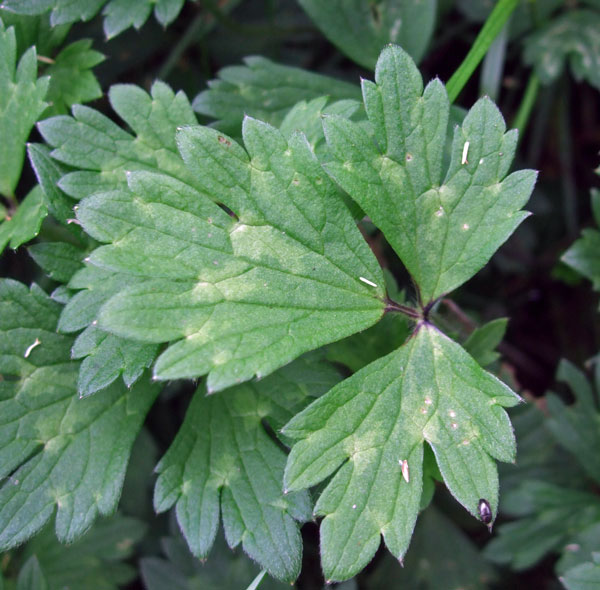 Botanical Name: Ranunculus repens
Botanical Name: Ranunculus repens
Family: Ranunculaceae
General information
Creeping buttercup is perennial weed and the most common of the buttercups found in turf. It is an easy weed to recognise with its lovely golden yellow flowers that can add an array of colour if the infestation is widespread.
It prefers heavy wet soils that often suffer from prolonged wetness and water logging. A presence of creeping buttercup is often a good indicator of the aforementioned symptoms and remedial action needs to be taken to improve the drainage. It is rare to find it on dry, free draining sites.
It is particularly troublesome in mown turf as it forms as a low growing rosette that can withstand a low cutting height. It is an invasive weed and can quickly colonise areas of turf. If left undisturbed it can grow to a height of 50cm.
As its name suggests this invasive weed spreads by stolons (overground runners), rooting at nodes with a deep fibrous root system. Creeping buttercup can also reproduce from seed.
Identification
- Leaves: The leaves are borne on long, hairy stalks ranging from 15mm – 250mm in length. They are dark green, sometimes with pale or dark flecks and are under close inspection covered in fine hairs. The basal leaves are divided into three segments (leaflets), each segment being deeply cut or lobed. The measure anything from 15mm – 80mm in length.
- Flowers: The golden yellow flowers are typical of most buttercups. Measuring 20mm – 30mm across they are borne singular or in clusters on long, hairy stalks. Each flower consists of between 5 – 7 glossy yellow petals. On the underneath side of the petals are 5 green sepals (green floral leaves) that are somewhat shorter than the petals. The main flowering period of creeping buttercup is between May and August.
- Roots: This weed has fibrous roots (see image below)
Creeping Buttercup Images (click image to enlarge)
More images and free downloads of Creeping Buttercup
Prevention and control of creeping buttercup
Promote healthy turf with good turf care practices, such as applying adequate nutrition and carrying out regular scarification & top dressing etc.
As creeping buttercup is often an indication of poor drainage, practices, such as regular aeration that promote a dry turf surface will help prevent the weed invading.
Raking the weed into an upright position prior to mowing will help weaken the weed.
Hand weeding can prove effective if the infestation is not too severe, take care to remove the whole plant including the roots and runners.
Creeping buttercup is easily controlled with a single treatment of selective weedkiller. Most products available will do the job.
If the weeds are few in number, consider using a spot weeder and just treat the individual plants. Always try and keep chemical use to a minimum.
Selective weed killers are more effective during periods of strong growth.
Selective weed killers recommended for the control of creeping buttercup
Professional products (The user requires the appropriate certificate/s to apply these products)
Headland Relay Turf (Mecoprop-p, Dicamba, MCPA)
Headland Cabadex (Fluroxypyr, Flurosulam)
React Ultra (Mecoprop-p, Dicamba, MCPA)
Everris Praxys (Clopyralid, Fluroxypyr, Fluosulam)
Bayer Longbow (Mecoprop-p, Dicamba, MCPA)
Barclay Holster XL (2,4-D, Fluroxypyr, Dicamba)
Mascot Greenor (Clopyralid, Fluroxypyr, MCPA)
Mascot Junction (2,4-D, Flurosulam)
Mascot Crossbar (2,4-D, Flurosulam, Dicamba)
Vitax Esteem (2,4-D, Clopyralid, MCPA)
Products available for non-professional use (These products are available from garden centres and DIY stores.)
Verdone extra (Clopyralid, Fluroxypyr, MCPA)
Resolva lawn weed killer (2,4-D, Mecoprop-p, MCPA, Dicamba)
Doff lawn spot weeder (2,4-D, Mecoprop-p, Dichlorprop-p)
Vitax Lawn Clear (2,4-D, Clopyralid, MCPA)
Vitax Green up weed & feed (Dicamba, MCPA)
Weedol lawn weed killer (Clopyralid, Fluroxypyr, MCPA)
Scotts lawn builder weed & feed (2,4-D, Dicamba)






